
Probably most fish keepers gravitate over time to aquariums of Lake Malawi Cichlids. This is due to the incredible colors which rival those of reef dwelling fish. So this article discusses largely Lake Malawi cichlids. Note that most of the photos in this article will drive the fish police absolutely bonkers. They have Lake Malawi, Lake Tanganyikan, Lake Victorian and even Central American cichlids like parrots and convicts all mixed together. There is nothing wrong with that. I have even put schools of tiger barbs in a Lake Malawi aquarium quite successfully.
But note one thing. Lake Malawi cichlids are simply very aggressive.
.
Any hobbyist WILL have aggression issues and deaths due to aggression in ANY Lake Malawi Aquarium.
.
If you do not like aggression issues I suggest a South American cichlid aquarium with angelfish, discus, severums, geophagus, and acara. You will have much lower aggression issues.
I’ve kept Malawi’s for over thirty years, and I’ve compiled a bunch of snippets saying what I’ve learned about Lake Malawi Cichlids:
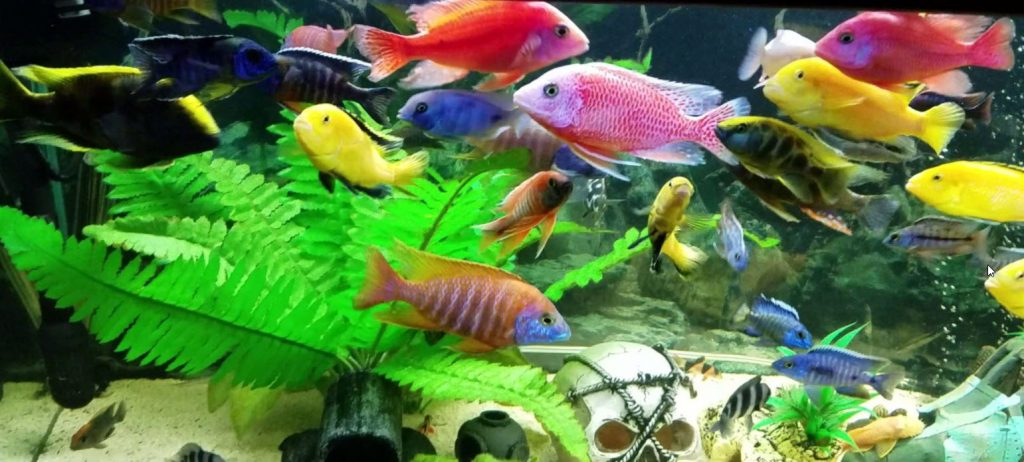
1, Possibilities for a Malawi Aquarium
Lake Malawi African cichlids are easy fish, no big problem for beginners. Water parameters are very flexible (Yes, Malawi’s do fine in 3 dGH on up and 7.0 pH on up) and you can put 37 in a 75-gallon aquarium. The short course in Malawi’s is as follows (note there are no “rules” here, only broad suggestions frequently very successfully broken):
After many years and thousands of “attitude adjustments”, my Malawi aquariums had pretty well segregated themselves into three combinations, all with heavy stocking (one four to six-inch fish for every two gallons), heavy filtration and heavy water changes. I find heavy stocking is required to keep aggression down.
In all aquariums I avoided Malawi’s over six inches like P. crabro (bumblebees), Moori (blue dolphins), Protomelas (red empress) and most predator Haps. I did this because an eight-inch fish needs four times more filtration than a five-inch fish. I also pointedly avoided Melanochromis (especially auratus) and Nimbochromis (especially fusco’ and venustus) as they have been frequent killers in my aquariums when they reach maturity.
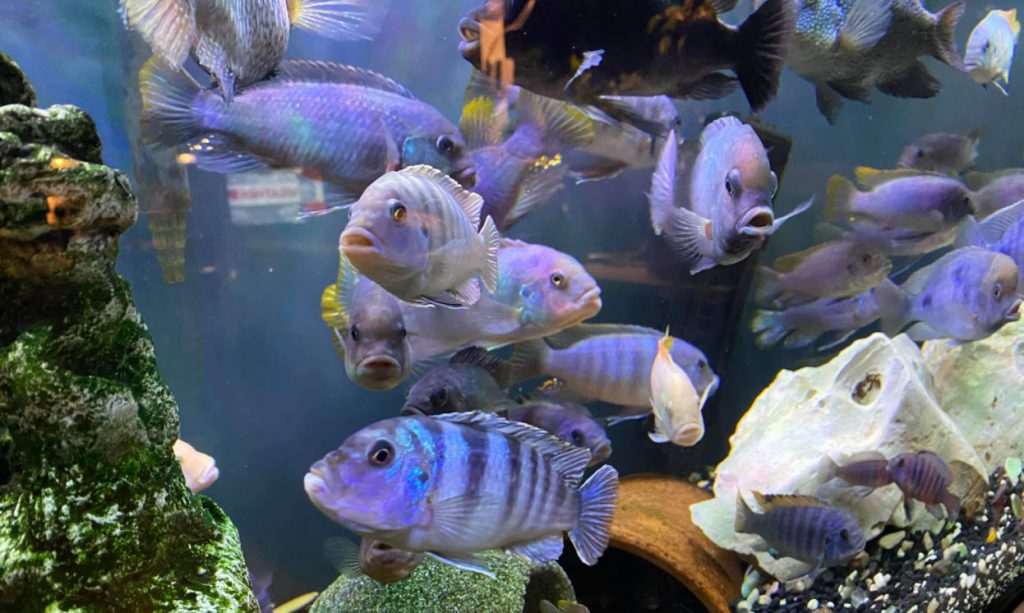
If I had a heavily stocked aquarium I mixed sexes with mbuna but stock only male Haps and Peacocks. If I had a lightly or moderately stocked Malawi aquarium I used only males, including only male mbuna.
- For an aggressive Malawi aquarium, I used all Maylandia, Labeotropheus, Pseudotropheus and Tropheops. I avoided acei, Labidochromis and most peacocks in the aggressive mbuna aquarium as they seem to get picked on too much. I’ve found haps and peacocks that will mix with aggressive mbuna include fryeri and jacobfreibergi.
- In my moderately aggressive Malawi aquarium, I stocked Labidochromis (many attractive species, including “Electric Yellow”, “hongi” and “Pearl of Likoma”), acei, Cynotilapia, and most Maylandia. I’ve also added to these aquariums OB peacocks and small peaceful haps (Otopharynx tetrastigma, Otopharynx lithobates, Lethrinops, Placidochromis, small Copadichromis). I avoided aggressive mbuna (Maylandia lombardoi [“Kenyi”], demasoni, Labeotropheus, and most Pseudotropheus), fryeri, and jacobfreibergi.
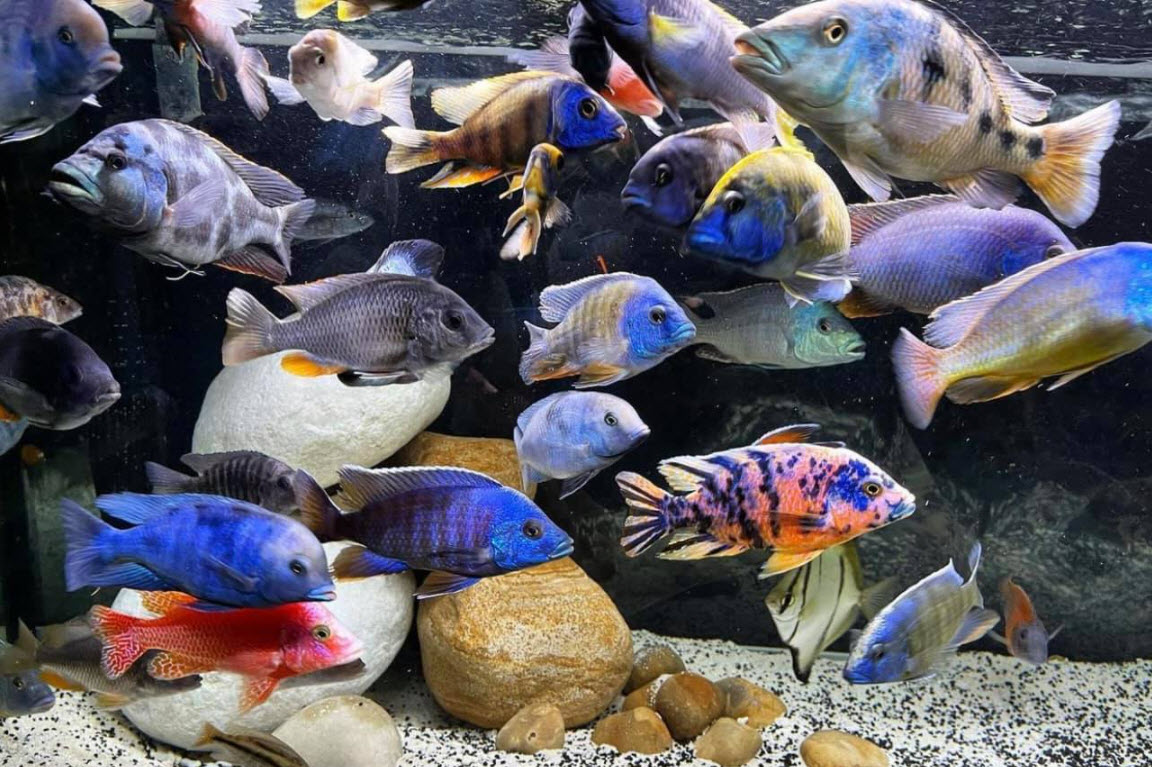
- In my “most peaceful” Malawi aquarium I had Labidochromis (many attractive species including “Electric Yellow”, “hongi” and “Pearl of Likoma”), P. acei and C. zebroides mbuna. I’ve also added to these aquariums peacocks of many color variations and small Lethrinops. I avoided Maylandia, Tropheops, demasoni, Haps, fryeri, jacobfreibergi, most Pseudotropheus and, surprisingly, OB peacocks.
- Note that cichlids are individualistic. Even a peaceful Yellow Lab can go on a testosterone fueled Vulcan “Pon Farr”. There are no guarantees. “Live long and prosper”
Note also that this is only my anecdotal experiences and as such are very far from “established fact”. Many have undoubtedly had completely different experiences.
Photo: Note the Lake Victoria Obliquidens, mbuna, predator haps and peacocks in the aquarium below:
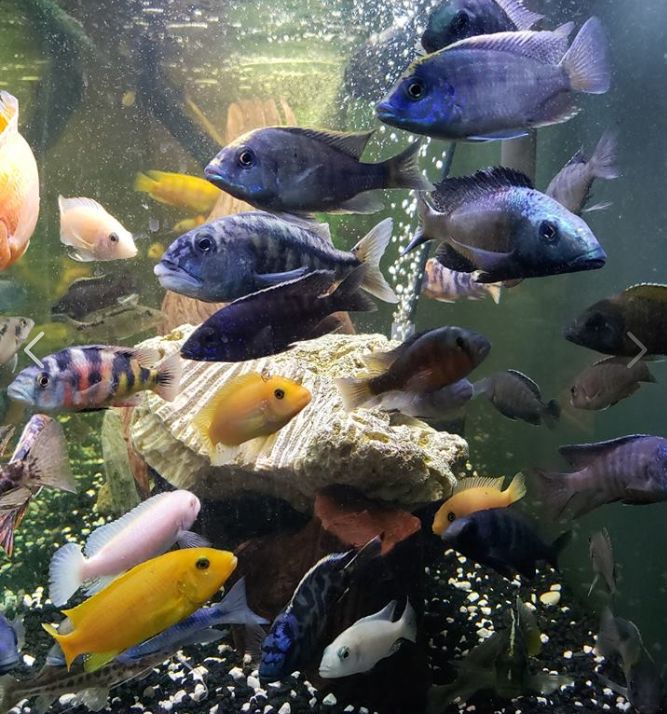
2, Mbuna Aquarium
After many years and thousands of “attitude adjustments”, my mbuna aquariums had pretty well segregated themselves into two combinations, all with heavy stocking (one four to six-inch fish for every two gallons), heavy filtration and heavy water changes.
I find heavy stocking is required to keep aggression down. And I stock both males and females in the same aquarium as well as males of the same species IF I USE HEAVY STOCKING. In light or moderate stocking use only males.
Photo: Note the mix below and the heavy stocking. These are largely predator haps, peacocks, mbuna, a Moori, a parrot and a frontosa.
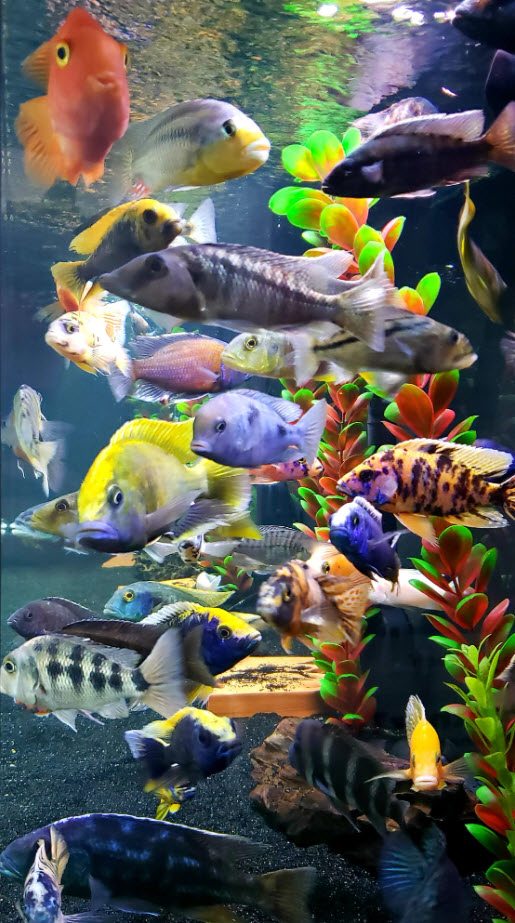
In all mbuna aquariums I avoided large mbunas like P. crabro (bumblebees). I did this because a eight-inch fish needs four times more filtration than a five-inch fish. I also pointedly avoided Melanochromis (especially auratus) as they have been frequent killers in my aquariums when they reach maturity. Note the use of the word “frequent”, sometimes these fish are quite peaceful. The aggression level of any cichlid cannot be predicted with certainty.
- For an aggressive mbuna aquarium, I used male and female of all Maylandia, Labeotropheus, Pseudotropheus and Tropheops. I avoided acei and Labidochromis in the aggressive mbuna aquarium as they seem to get picked on too much.
- In my “peaceful” mbuna aquarium, I stocked male and female Labidochromis (many attractive species, including “Electric Yellow”, “hongi” and “Pearl of Likoma”), acei, Cynotilapia, and most Maylandia. I avoided aggressive mbuna (Maylandia lombardoi [“Kenyi”], Labeotropheus, demasoni, and most Pseudotropheus).
- Note that cichlids are individualistic. Even a peaceful Lab can go on a testosterone fueled Vulcan “Pon Farr”. There are no guarantees. Live long and prosper.
Note also that this is only my anecdotal experiences and as such are very far from “established fact”. Many have undoubtedly had completely different experiences.
Photo: Note the mix of Jack Dempseys and parrot cichlids in with the Malawis
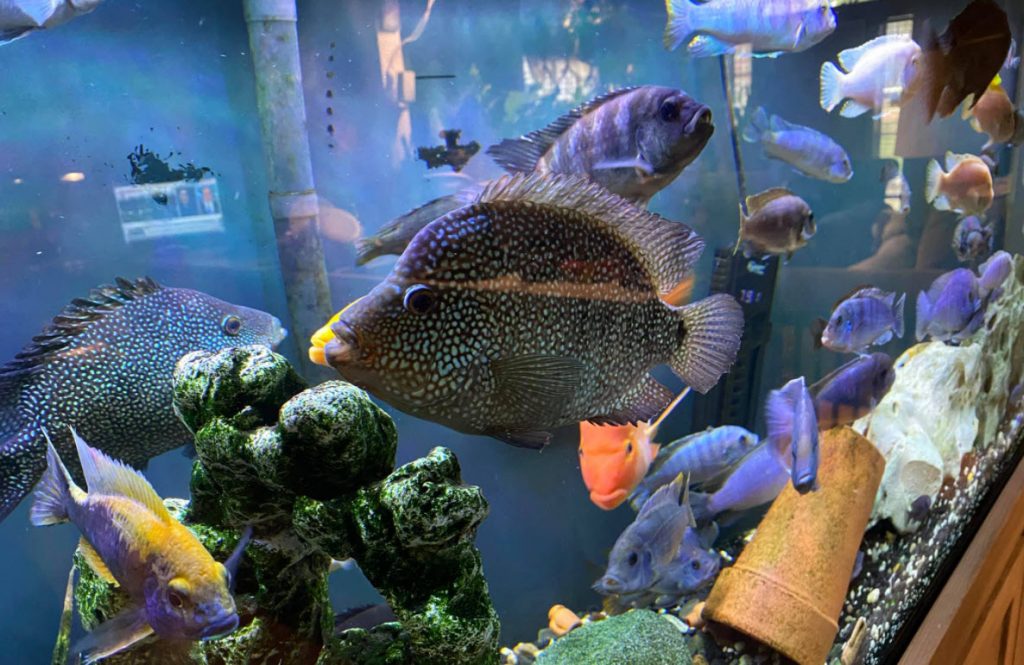
3, Peacock Aquariums
When it comes to stocking peacocks there are no “rules” only broad suggestions frequently very successfully broken. I stocked peacock aquariums with ONLY MALES at one fish per two gallons. I stocked either species peacocks or hybrids (Dragon Blood, Flame, OBs) in any given aquarium. You can mix them, but it can be a challenge as some hybrids are buttholes to species peacocks. As the stocking levels go up the ability to mix the OB’s and the species peacocks goes up as well.
Aquarium mates for Peacocks can include male Labidochromis (many attractive species including Electric Yellow”, “hongi” and “Pearl of Likoma”) and males of some small haps like Otopharynx lithobates, small Placidochromis, small Copadichromis and small Lethrinops. I avoid jacobfreibergi peacocks as they get too big and nasty.
Note that this is only my anecdotal experiences and as such are very far from “established fact”. Just my experience, others will have a different tale to tell.
Photo: Note the mix of Malawi’s below:

4, Stocking Predator Haps
Generally, with females in a predator hap aquarium, I find only one male hap will color up. This “dominant” male hap will SOMETIMES then try to kill all the other males (SOMETIMES they will be “gentle giant” tank bosses). I have had much better color overall and the least aggression in a lightly stocked all male predator hap aquarium. I have had huge problems with a moderately or heavily stocked hap aquarium. They just didn’t work for me.
There are unfortunately some haps like the sulfur heads that only color up well in the presence of females. So these haps have to be in breeding colonies in species only tanks to get the best color. But the color without females is still very good so I wouldn’t let that deter one.
Note that this is only my anecdotal experiences and as such are very far from “established fact”. Just my experience, others will have a different tale to tell.
Photo: Find the Midas cichlid below (a Central American hybrid fish)

5, Mixing Other Biotopes with Malawi Fish
This is a topic about which many well meaning but ill-informed individuals on social media have some very strong views. I’ve had many fish from different biotopes in Malawi tanks including Tanganyikans, Victorians, jewels, silver dollars, parrots, giant danios, rainbowfish, scats, monos, clown loaches, plecos, American cichlids (at least 50% larger than the biggest lake Malawi and they’ll do fine), schools of tiger barbs, etc. etc. All have done well with only minor issues. And I stocked one fish per two gallons.
Photo: Note the convicts (Central American fish) and Tanganyikan in with these Malawis

When it comes to fish selection with cichlids, I like the old standard of “Just do it”. Will you have aggression issues? Sure. But that’s true in any cichlid aquarium. Will it be a challenge, yes, but don’t most of us enjoy a challenge? Both diet and water chemistry are vastly over-rated as important factors in keeping fish. The bacterial count in the water is far more important. The aquarium is a natural system and Mother Nature is very flexible. But the fish police will call me out for these comments. I’ll go whip myself now to get a head start.
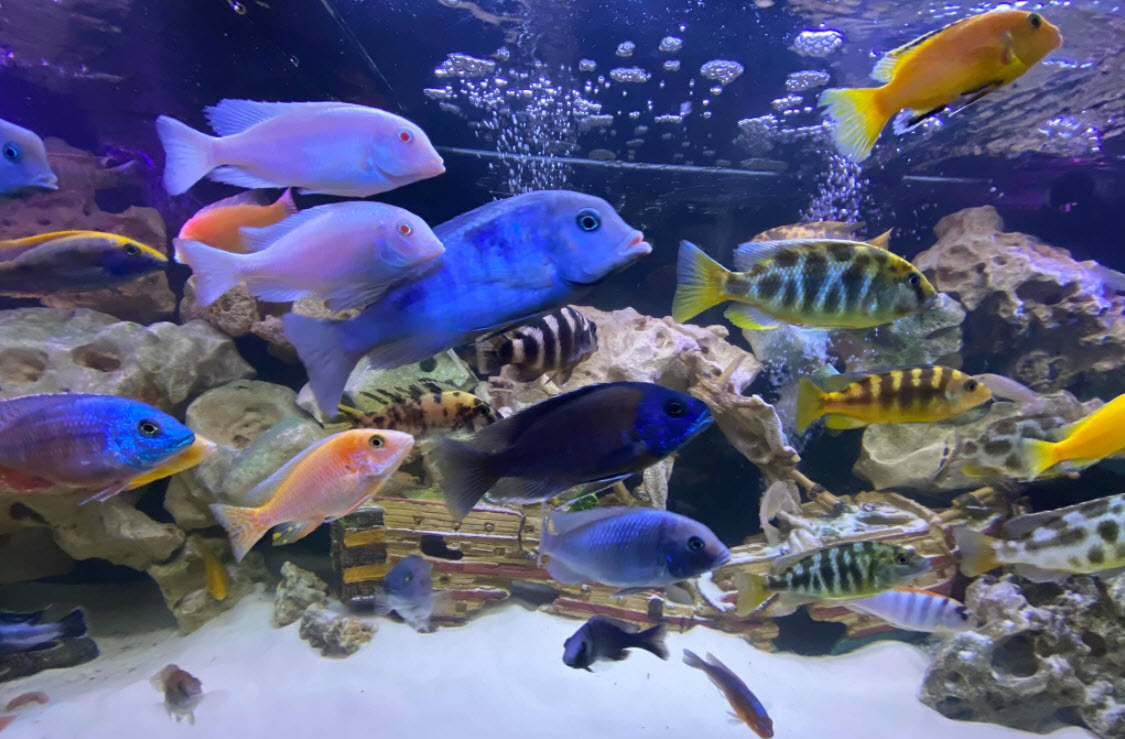
6, Water Chemistry
Salt and aquarium salt are sodium chloride. Seachem Cichlid Lake Salt is largely chlorides if you read the label. Lake Malawi is very low in chlorides (<4 ppm). So why would you use salt or Lake Salt in a Malawi tank? I’m not saying it doesn’t help to add salt of any sort. But adding salt does not duplicate what the Malawi fish sees in the wild.
And Seachem high buffer is largely cheap baking soda (sodium bicarbonate) at a very high price. Seachem Cichlid Trace is a bunch of minerals found in virtually all tap water in quite sufficient quantities for any fish.

I don’t consider salts, pH, buffering (KH) or hardness (GH) to be very important. But if one is a perfectionist with a Lake Malawi tank, there are three ways to buffer to an alkaline pH level:
1, add coral or aragonite substrate to the tank or in the filter in a bag. That will buffer to 7.6 to 7.9 pH.
2, simply add three level teaspoons of baking soda per 25 gallons of soft neutral water
3, add the following recipe to 25 gallons of neutral soft change water:
- 1/4 teaspoon Epsom salts (magnesium sulfate)
- 1 level teaspoon Plaster of Paris (calcium sulfate)
- 2 level teaspoons baking soda (sodium bicarbonate)
The third option duplicates the water chemistry of Lake Malawi very closely. Note that commercial buffers can’t duplicate this formula since it would harden on a shelf after mixing.

7, Food to Prevent Malawi Bloat.
I know many say high protein diets with mbuna cause constipation and “Malawi bloat”. But humans don’t get constipation from too much protein, they get it from too little fiber. Why should mbuna be any different?
For some 15 years I had fed ten aquariums heavily stocked with largely mbuna homemade gel made of 25% cooked spinach (high fiber food) and 75% uncooked fish filet (high protein food) with some 3% Knox gelatin. This food is roughly 66% protein, decidedly a high protein food. Yet I can’t remember my last case of bloat or “white poop”.
- Tazawa recommends lots of fiber and lots of indigestible chitin (whole shrimp, mysis or krill) for mbuna. He’s had very good luck avoiding bloat with this approach.
- I always am intrigued by the fact that the periphyton or “aufwuchs” that Mbuna eat in the wild is 55% protein, 15% fiber and 15% digestible carbohydrate by dry weight. This is identical to the composition of vegetables like spinach, green beans and zucchini. It is not the composition of any dry fish food I know of. Wheat, oats, rice, corn, etc. are largely (70%) carbohydrates, not what ANY fish eats in the wild. And there is no such thing as “low-quality” or “high-quality” protein. Protein is composed of 22 to 25 amino acids and only a few plant food sources lack some of the amino acids.
- When I point these facts out to the fish police I’m told the problem is with “animal protein”. Note the first three to four ingredients in almost all pelleted fish food is something along the line of Shrimp, Herring Meal, Sardine Meal, Krill Meal and/or Fish Meal followed by fillers such as wheat, rice and/or potatoes. Shrimp and fish were animals the last time I checked. HHhhhmmmm????
- And the amino acid composition of proteins from land based animals is identical to the amino acid composition of water based animals, so there is no difference in the protein from the two sources.
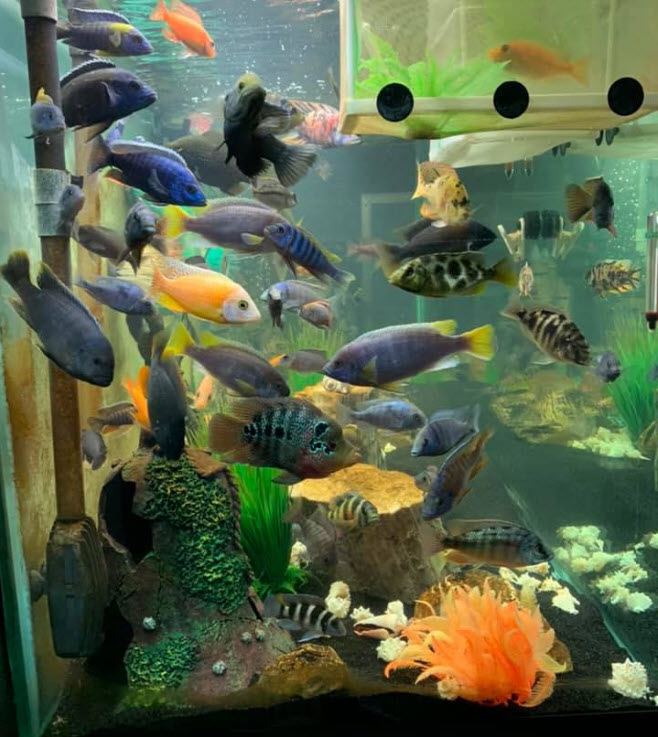
8, Reducing Aggression in Malawi Cichlids
When it comes to cichlids there are no hard and fast rules on aggression. Auratus cichlids are considered by may to be the “devil fish” because they are so vicious. Yet I’ve had dominant auratus males that were decidedly mellow in a lightly stocked aquarium. Yellow Labs are normally mellow yet I’ve had yellow labs go on killing sprees in heavily stocked tanks. I’ve had giant bumblebee males that were “gentle giants” in the tank and I’ve had some bumblebees which were killers.
Cichlids of ANY species are simply unpredictable. I’ve kept an Oscar that killed anything put in the tank with him, and I mean ANYTHING. I had another Oscar that lived for years with a feeder goldfish. Jewel cichlids are another very unpredictable fish, as are convicts and Parrots. This is why there is so much contradictory advice when it comes to cichlid compatibility. When it comes to cichlids, I like the motto of “just do it”.
Note there is one notable exception here. I have never had or seen a Flowerhorn Cichlid which could live with anything except another Flowerhorn. They are all just very vicious.
I’ve found the following possible ways to reduce aggression in Cichlids useful:
- Most important, do your research and for a given tank select species of fish which are the same aggression level (cichlid-forum.com/profiles).
- Understand that SOME Melanochromis, Nimbochromis and “predator haps” males are very aggressive. Some rightfully call SOME of these species’ “killers”, especially as FULLY-GROWN ADULTS (juveniles are typically mellow). Only stock them if you enjoy a challenge.

- Most mbuna and mixed tanks typically require heavy stocked (at least one 4” fish per two gallons and a minimum of 29 gallons and 15 fish) to reduce aggression (they also typically require heavy water changes and huge amounts of over-filtration). Note that a predator hap tank typically requires light stocking.
- Sex is important (Can’t believe I just said that, duh). For mbuna, I found I can mix sexes in heavily stocked tanks. In lightly or moderately stocked tanks I stocked only male mbuna. For peacocks and haps, I only stocked males.
- I didn’t provide caves where fish can create territories.
- I always added new fish at least three at a time.
- I kept the lights off except when feeding or “admiring”
- Typically the cooler the water the less the aggression. Lake Malawi averages 75 and I kept my Malawi’s at 70 to 75.
.
ALL these points are only gross generalizations which only work some of the time.
.
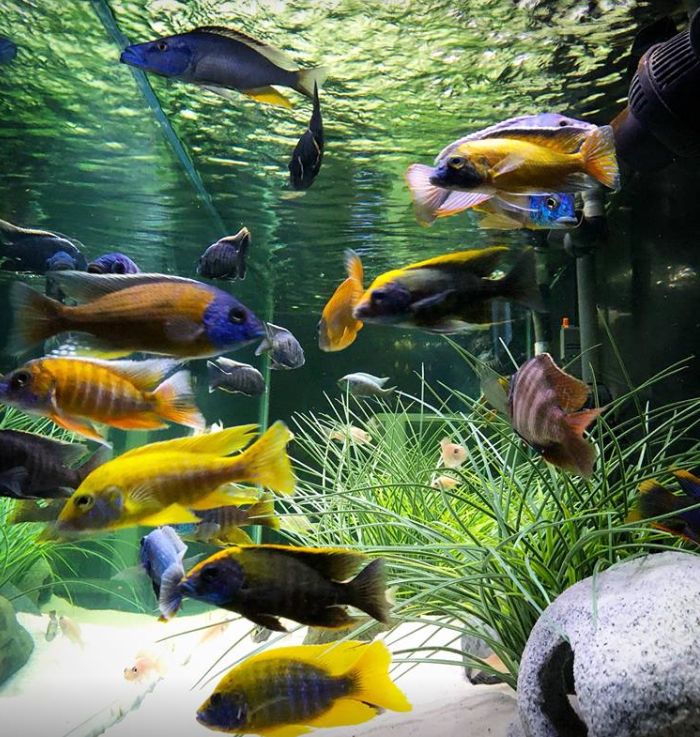
9, Stocking Numbers in More Detail
We go into stocking in much more depth in this link:
13.2. Stocking an Aquarium
But a simplified version is shown below:

Note that these charts are based on the volume and the weight of the fish. It is important to remember that a ten inch fish will have eight times the volume and the weight of a five inch fish. Note I have NO PROBLEM with Lake Malawi fish in a 25 gallon aquarium. Some on social media seem to think putting any Lake Malawi fish in less than a 50 Gallon aquarium is a horrible thing punishable by death. Ignore them.
As a general rule I find haps need light stocking and mbuna need heavy stocking. Peacocks can adapt to any stocking. Note that this is only my anecdotal experiences and OPINION on stocking. As such these are very far from “established fact”. Just my experience, others will have a different tale to tell.
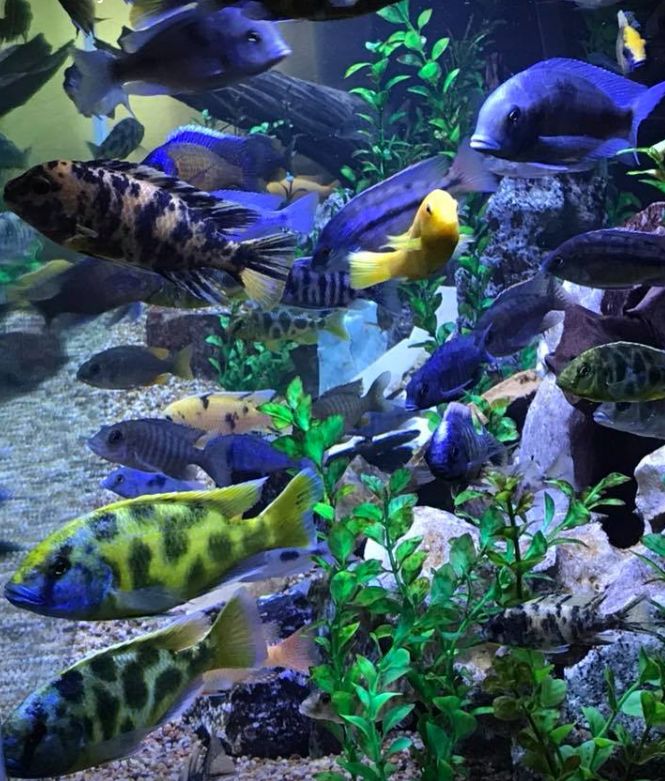
10, Filtration
Because all my Malawi aquariums were heavily stocked, I had huge amounts of filtration on them. All the large aquariums have 3/16 ths gravel substrates with undergravel filters with powerheads on the lift tubes. All the large aquariums also had sumps with K1 fluidized beds. Some of my large tanks even had FX6 canisters on them, filled with pot scrubbers. Some of the smaller aquariums like my quarantine tank had FX4 canisters. And each of the breeding tanks had two air operated operated sponge filters and one air operated undergravel filter.
All my tanks except the breeding tanks have UV sterilizers on them. I like UV sterilizers and I have a regular periodic maintenance I do on them. I also replace the bulbs once a year.
Note that one common old myth about peacocks is that they require a sand bottom and can damage their gills on a gravel bottom. I’ve had tons of peacocks on 3/16 gravel substrates with no gill damage what-so-ever. Yes, it is true that peacocks sand sift in their native waters. But they simply stop sifting if presented with gravel.
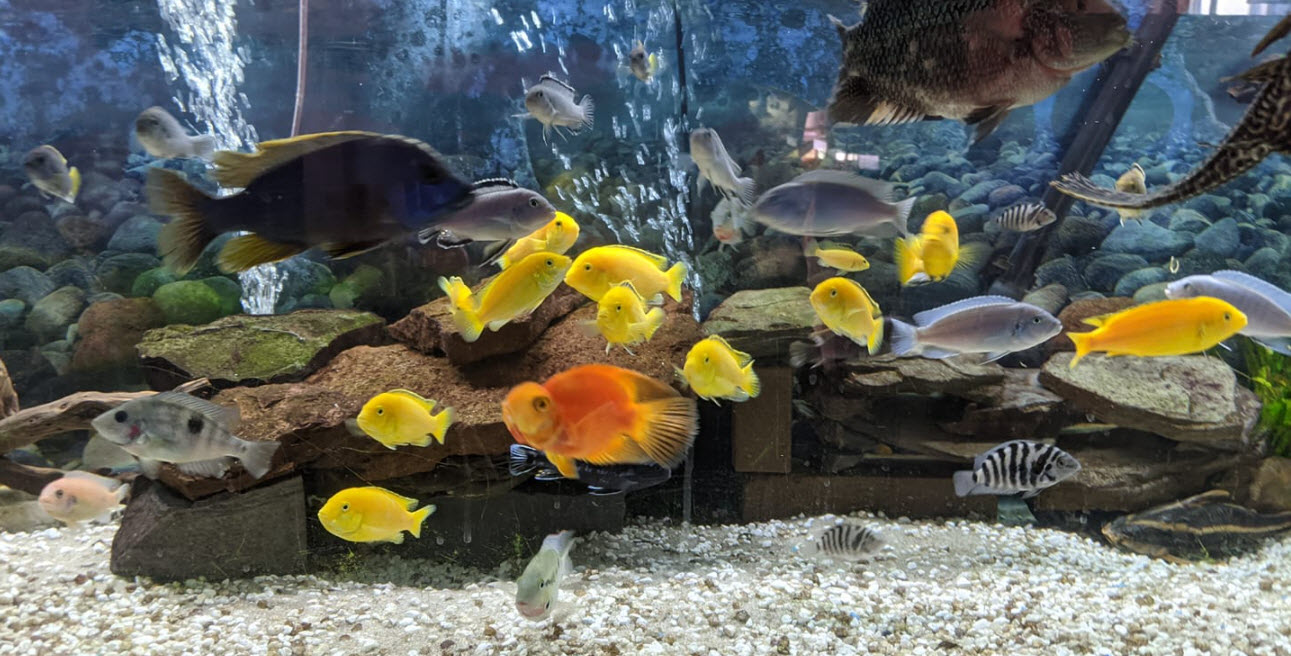
Plants and Africans.
To put it simply, plants do not mix with Lake Malawi Cichlids. I ran across this newly set up Malawi tank. LOL. These Africans will tear these plants apart in short order. …. OK … hmmm I was wrong!
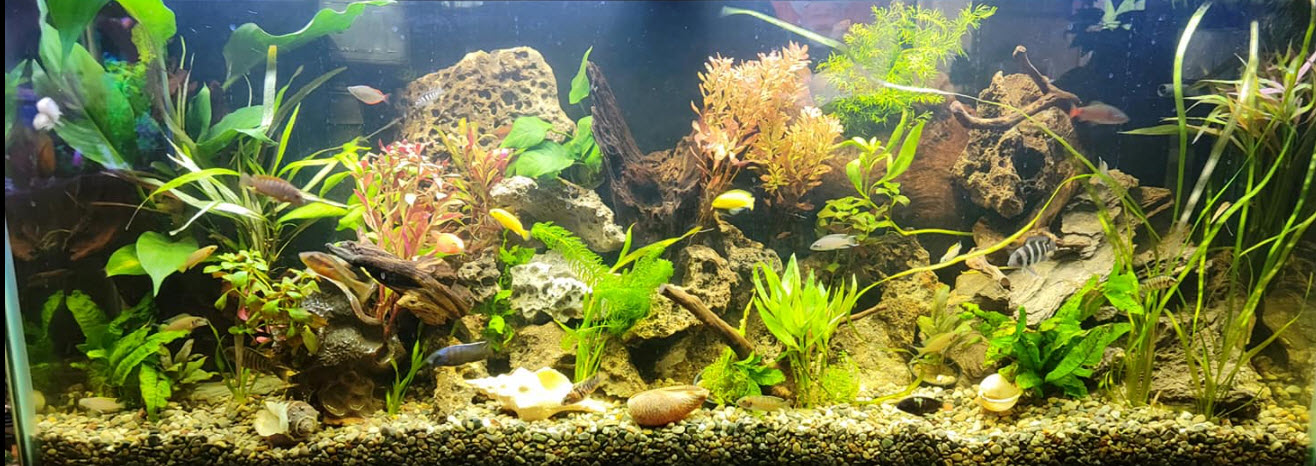
Now after I wrote what was above I found this aquarium on social media:

There is some vallisneria and a lot of Amazon swords (Echinodorus amazonicus and E. bleheri). This tank is a year and a half old with crushed lava rock substrate and a pH of 7.0. The fish have been in it the whole time and are decidedly overstocked, which I would have said was completely and totally impossible. Gorgeous and amazing! So much for my pale attempts at a planted tank with Africans. This tank also points out how a low pH does not prevent one from having Lake Malawi Cichlids.
Photos of Malawi Aquariums
Many newcomers to the hobby who are getting into Lake Malawi Cichlids want ideas as to how to set up and stock their tanks. So I’ve compiled a list of pictures of Lake Malawi aquariums I’ve seen on social media. This link may take a long time to load.
17.4.1. Lake Malawi Aquariums
.
Return to Fish Selection Menu
.
Aquarium Science Website
The chapters shown below or on the right side in maroon lead to close to 400 articles on all aspects of keeping a freshwater aquarium. These articles have NO links to profit making sites and are thus unbiased in their recommendations, unlike all the for-profit sites you will find with Google. Bookmark and browse!
.

Dave says
In reply to Amit ….. I would go with the peaceful mbuna mix listed in this article (largely labidochromis). A few of them will push five inches but that OK in a thirty gallon. Change the water when the nitrates hit 80.
Amit says
Sir David, I am now cycling a 30 Gallon Tank to keep cichlids. Undergravel filter with a power head and used crushed coral as gravel (no hiding spots). Looking for colorful fishes. Are there any species you can tell me which will be good colors mix and below 4 inches max length (easy to find, maybe). How many can I stock in my aquarium and with that number how much water change I need to do weekly? Should I get baby (small) fish or medium length. Local stores just sell Cichlids and they know very less about the Mbuna, peacock and haps difference (me too 😂). Went to cichlid forum but couldn’t find a list of peacocks or other cichlids below 4 inch max length. If you can direct me to a source also will be fine. Thank you for sharing your valuable experience with utmost honesty. Thank you so much 🙏🙏
Rhys says
I can agree with a lot of what’s on this list, I’ve been told no you can’t do that for the majority of my tank.
Australian catfish (tandanus)
Indonesian red rainbows
Plants.
Neon jewels, geophagus, yellow labs, white tail acei, yellow tail acei, white lips Mdoka, peacocks and Siamese algae eaters all mixed together in a 55gal tank.